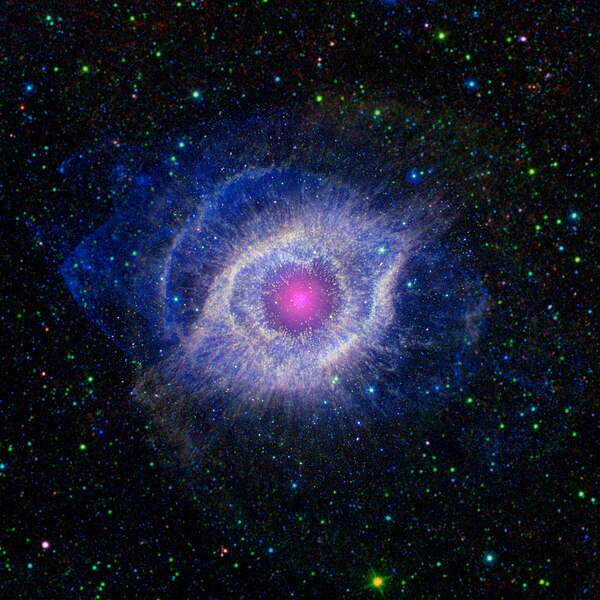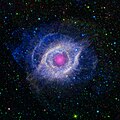ファイル:Helix Nebula - Unraveling at the Seams.jpg

元のファイル (6,019 × 6,019 ピクセル、ファイルサイズ: 14.92メガバイト、MIME タイプ: image/jpeg)
ウィキメディア・コモンズのファイルページにある説明を、以下に表示します。
|
概要
| 解説Helix Nebula - Unraveling at the Seams.jpg |
English: A dying star is throwing a cosmic tantrum in this combined image from NASA's Spitzer Space Telescope and the Galaxy Evolution Explorer (GALEX), which NASA has lent to the California Institute of Technology in Pasadena. In death, the star's dusty outer layers are unraveling into space, glowing from the intense ultraviolet radiation being pumped out by the hot stellar core.
This object, called the Helix nebula, lies 650 light-years away, in the constellation of Aquarius. Also known by the catalog number NGC 7293, it is a typical example of a class of objects called planetary nebulae. Discovered in the 18th century, these cosmic works of art were erroneously named for their resemblance to gas-giant planets. Planetary nebulae are actually the remains of stars that once looked a lot like our sun. These stars spend most of their lives turning hydrogen into helium in massive runaway nuclear fusion reactions in their cores. In fact, this process of fusion provides all the light and heat that we get from our sun. Our sun will blossom into a planetary nebula when it dies in about five billion years. When the hydrogen fuel for the fusion reaction runs out, the star turns to helium for a fuel source, burning it into an even heavier mix of carbon, nitrogen and oxygen. Eventually, the helium will also be exhausted, and the star dies, puffing off its outer gaseous layers and leaving behind the tiny, hot, dense core, called a white dwarf. The white dwarf is about the size of Earth, but has a mass very close to that of the original star; in fact, a teaspoon of a white dwarf would weigh as much as a few elephants! The glow from planetary nebulae is particularly intriguing as it appears surprisingly similar across a broad swath of the spectrum, from ultraviolet to infrared. The Helix remains recognizable at any of these wavelengths, but the combination shown here highlights some subtle differences. The intense ultraviolet radiation from the white dwarf heats up the expelled layers of gas, which shine brightly in the infrared. GALEX has picked out the ultraviolet light pouring out of this system, shown throughout the nebula in blue, while Spitzer has snagged the detailed infrared signature of the dust and gas in yellow A portion of the extended field beyond the nebula, which was not observed by Spitzer, is from NASA's all-sky Wide-field Infrared Survey Explorer (WISE). The white dwarf star itself is a tiny white pinprick right at the center of the nebula. The brighter purple circle in the very center is the combined ultraviolet and infrared glow of a dusty disk circling the white dwarf (the disk itself is too small to be resolved). This dust was most likely kicked up by comets that survived the death of their star. Before the star died, its comets, and possibly planets, would have orbited the star in an orderly fashion. When the star ran out of hydrogen to burn, and blew off its outer layers, the icy bodies and outer planets would have been tossed about and into each other, kicking up an ongoing cosmic dust storm. Any inner planets in the system would have burned up or been swallowed as their dying star expanded. Infrared data from Spitzer for the central nebula is rendered in green (wavelengths of 3.6 to 4.5 microns) and red (8 to 24 microns), with WISE data covering the outer areas in green (3.4 to 4.5 microns) and red (12 to 22 microns). Ultraviolet data from GALEX appears as blue (0.15 to 2.3 microns). |
| 日付 | (released) |
| 原典 | http://www.nasa.gov/multimedia/imagegallery/image_feature_2368.html; see also https://photojournal.jpl.nasa.gov/catalog/PIA15817 and http://www.spitzer.caltech.edu/images/5259-sig12-011-The-Helix-Nebula-Unraveling-at-the-Seams |
| 作者 | NASA/JPL-Caltech |
| このタグは、添付された著作物の著作権状況を示すものではありません。通常の著作権タグも必要です。Commons:ライセンシングもご覧ください。 他言語での翻訳:
العربية ∙ беларуская (тарашкевіца) ∙ български ∙ català ∙ čeština ∙ dansk ∙ Deutsch ∙ English ∙ español ∙ فارسی ∙ français ∙ galego ∙ magyar ∙ հայերեն ∙ Bahasa Indonesia ∙ italiano ∙ 日本語 ∙ македонски ∙ മലയാളം ∙ Nederlands ∙ polski ∙ português ∙ русский ∙ sicilianu ∙ slovenščina ∙ Türkçe ∙ українська ∙ 简体中文 ∙ 繁體中文 ∙ +/− |
ライセンス
| Public domainPublic domainfalsefalse |
| このファイルはアメリカ航空宇宙局(NASA)によって作成されたものです。NASAの著作権の方針では、特記事項が無い場合、NASAの資料はパブリックドメインとなります。 (詳しくはTemplate:PD-USGov、NASAの著作権の方針について(英語)又はジェット推進研究所(JPL)の画像使用に関するガイドライン(英語)をご覧ください。) |
 | |
 |
注意事項:
|
キャプション
このファイルに描写されている項目
題材
2 10 2012
image/jpeg
ファイルの履歴
過去の版のファイルを表示するには、その版の日時をクリックしてください。
| 日付と時刻 | サムネイル | 寸法 | 利用者 | コメント | |
|---|---|---|---|---|---|
| 現在の版 | 2012年10月8日 (月) 20:08 |  | 6,019 × 6,019 (14.92メガバイト) | Mutante | User created page with UploadWizard |
ファイルの使用状況
以下のページがこのファイルを使用しています:
グローバルなファイル使用状況
以下に挙げる他のウィキがこの画像を使っています:
- fr.wikipedia.org での使用状況
- pl.wikipedia.org での使用状況
- sk.wikipedia.org での使用状況
メタデータ
このファイルには、追加情報があります (おそらく、作成やデジタル化する際に使用したデジタルカメラやスキャナーが追加したものです)。
このファイルが元の状態から変更されている場合、修正されたファイルを完全に反映していない項目がある場合があります。
| ソース | Spitzer Space Telescope |
|---|---|
| 使用条件 | |
| 原画像データの生成日時 | 2012年9月27日 (木) |
| 画像の幅 | 6,019 ピクセル |
| 画像の高さ | 6,019 ピクセル |
| 画像のビットの深さ |
|
| 圧縮の種類 | LZW |
| 画素構成 | RGB |
| 画像方向 | 通常 |
| コンポーネント数 | 3 |
| 水平方向の解像度 | 72dpi |
| 垂直方向の解像度 | 72dpi |
| 画像データの並び | 点順次フォーマット |
| 使用ソフトウェア名 | Adobe Photoshop CS3 Windows |
| ファイル変更日時 | 2012年10月2日 (火) 10:40 |
| 色空間情報 | sRGB |
| 実効画像の幅 | 6,019 ピクセル |
| 実効画像の高さ | 6,019 ピクセル |
| 著作権情報 | 著作権情報未設定 |
| デジタルデータの作成日時 | 2012年10月2日 (火) 03:40 |
| メタデータの最終更新日 | 2012年10月2日 (火) 03:40 |
| 元文書の一意なID | xmp.did:99CC7C75FA236811822A8DEC83A20A0F |
| キーワード |
|
| 連絡先情報 |
http://www.spitzer.caltech.edu 1200 E. California Blvd. Pasadena, CA, 91125 USA |
